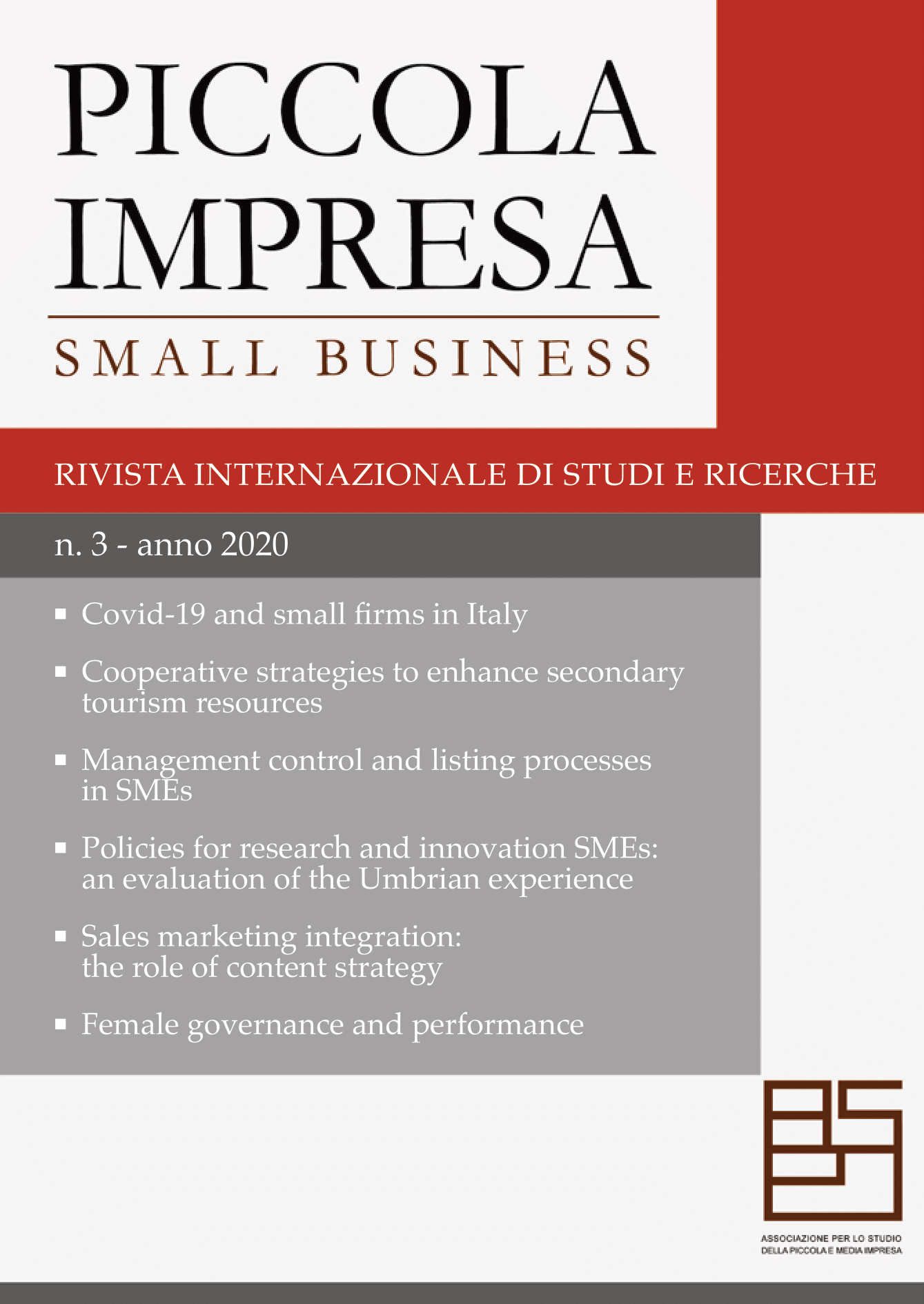Abstract
The article aims to analyze and evaluate public financial resources for applied scientific research and innovation provided to small umbrian manufacturing companies over the course of more than a decade (from 2007 to 2018). The evaluation of these policies is particularly important in the context of a territorial context characterized by a proliferation of small businesses, often operating within subcontracting chains on behalf of medium-large exogenous companies.
The methodology used is counter-factual model - using a statistical control sample made up of non-beneficiary companies - and the performance variables used refer to turnover, invested capital, employment and profitability. The conclusions show that these public financial resources have had a positive effect, in particular on turnover and employees, and to a much lesser extent on investments and profitability.
References
Arundel, A., & Hollanders, H. (2005). Policy, indicators and targets: Measuring the impacts of innovation policies. European Trend Chart on Innovation, MERIT, December 19th;
Barbieri, E., Iorio, R., & Lubrano Lavadera, G. (2010). Incentivi alla Ricerca & Sviluppo in Italia: una indagine sugli effetti della legge 46/82. L'industria, 31(2), 335-366;
Bianchi, T., & Severati, P. (2013). Valutare le politiche pubbliche. Il Mulino, 62(3), 418-426
Brancati R. (2001), Analisi e metodologie per la valutazione delle politiche industriali, Franco Angeli Editore, Milano
Cariola, M., Calabrese, G., & Rolfo, S. (2000). Principi teorici ed evidenze empiriche nella valutazione delle politiche per l’innovazione delle regioni italiane. III Convegno nazionale AIV;
Cefis, E., & Evangelista, R. (2007). La valutazione delle politiche per l'innovazione: un confronto tra Italia e Paesi Bassi. L'industria, 28(2), 243-264
Cunningham, J. A., & Link, A. N. (2016). Exploring the effectiveness of research and innovation policies among European Union countries. International Entrepreneurship and Management Journal, 12(2), 415-425;
Edler, J., Cunningham, P., & Gök, A. (Eds.). (2016). Handbook of innovation policy impact. Edward Elgar Publishing;
Evangelista, R. (2007). Rilevanza e impatto delle politiche dell’innovazione in Italia. I risultati delle indagini CIS. Economia e politica industriale, 1, 103-124;
Ferrucci L. (2008), La metamorfosi dell’industria manifatturiera in Umbria, in Agenzia Umbria Ricerche, Rapporto Economico e Sociale, Dentro L’Umbria, Perugia,
Ferrucci L. (2019), Le imprese manifatturiere del capitalismo familiare, in, a cura di, M. Tosti, La Regione e l’Umbria. L’istituzione e la società dal 1970 a oggi, Marsilio Editore, Venezia
Gabriele, R., Zamarian, M., & Zaninotto, E. (2007). Gli effetti degli incentivi pubblici agli investimenti industriali sui risultati di impresa: il caso del Trentino. L'industria, 28(2), 265-280;
Georghiou, L. (1998). Issues in the evaluation of innovation and technology policy. Evaluation, 4(1), 37-51;
Howells, J. (2005). Innovation and regional economic development: A matter of perspective?. Research policy, 34(8), 1220-1234;
Kuhlmann, S. (2003). Evaluation of research and innovation policies: a discussion of trends with examples from Germany. International journal of technology management, 26(2-4), 131-149;
Labory, S. (2006). La politica industriale in un'economia aperta e basata sulla conoscenza. L'industria, 27(2), 255-282;
Magro, E., & Wilson, J. R. (2013). Complex innovation policy systems: Towards an evaluation mix. Research policy, 42(9), 1647-1656;
Mangani, A., & Tramontana, E. (2020). La valutazione delle politiche industriali, Economica, 1(1);
Merito, M., Giannangeli, S., & Bonaccorsi, A. (2007). Gli incentivi per la ricerca e lo sviluppo industriale stimolano la produttività della ricerca e la crescita delle imprese? Evidenza sul caso italiano. L'industria, 28(2), 221-242;
Molas-Gallart, J., & Davies, A. (2006). Toward theory-led evaluation: The experience of European science, technology, and innovation policies. American Journal of Evaluation, 27(1), 64-82;
Montanari G., Ferrucci L., Silvestri S. (2019), Le politiche per la competitività e l’innovazione delle imprese in Umbria, F.Angeli Editore, Milano
Potì, B., & Cerulli, G. (2010). La valutazione ex-post di uno strumento di politica della ricerca industriale: modello analitico, processo di realizzazione, eterogeneità degli effetti. L'industria, 31(2), 307-334).
Rubin, D.B. & Thomas, N. (1996). Matching using estimated propensity scores: relating theory to practice”. Biometrics, 52, 249-64.
Santarelli, E., & Zaninotto, E. (2007). La valutazione degli effetti economici degli incentivi alle imprese. L'industria, 28(2), 195-198;
Viesti, G. (2013). La riscoperta della politica industriale: per tornare a crescere. Economia italiana, 3, 25-51;
Copyright and licensing: The journal supports the principles contained in the Berlin Declaration on Open Access to scientific literature (2003), reiterated in the Italian CRUI Guidelines on Open Access journals. Copyright Notice: papers made open to the public are published under the CC BY--4.0 license.
Archiving : This journal uses the LOCKSS system to create an archiving system, which is distributed between participating libraries and enables them to search through the permanent archives of the journal for the purposes of conservation and restoration. All journal data and publications are also saved and stored directly on the platform

